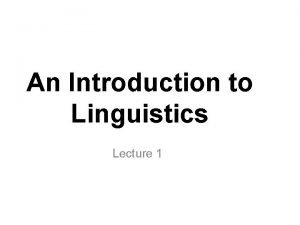English Linguistics An Introduction Chapter 8 Language and












- Slides: 12

English Linguistics: An Introduction Chapter 8 Language and Culture

Chapter 8 Language and Culture 0. Warm-up Questions 1. What Is Culture? 2. Language vs. Culture 3. Case studies 4. Pedagogical Implication 5. Intercultural Communication

0. Warm-up Questions ´ What is culture? What are different aspects of culture? ´ How are culture and language related to each other? ´ Can you produce some linguistic evidence of different cultures? ´ What are your suggestions for polite conversations? ´ What implications can we draw from the relationship, for both language learning and intercultural communication?

1. What Is Culture? Few statements about culture: Ø The set of shared attitudes, values, goals, and practices that characterizes an institution, organization or group. Ø A learned pattern of behavior and ways in which a person lives his or her life. Ø A term used by social scientists for a people's whole way of life. Ø Ø 人类在社会历史发展过程中所创造的物质和精神财富的总和。 人们普遍的社会习惯,如衣食住行、风俗习惯、生活方式、行 为规范等。

2. Language vs. Culture 2. 1 The Relationship (p 146) Ø Ø Language is an indispensable part and carrier of culture. Culture finds a better representation through language use. 2. 2 Sapir-Whorf Hypothesis (p 149) Ø Our language helps mould our way of thinking and, consequently, different languages may probably express speakers’ unique ways of understanding the world.

2. Language vs. Culture 2. 2 Sapir-Whorf Hypothesis (p 149) Two versions of the SWH: Ø Linguistic Determinism: Language determines thought. (strong version) Ø Linguistic Relativity: Language merely influences thought. (weak version)

3. Case studies 3. 1 Cultural Difference (p 154) Ø ü Ø ü Greetings How are you? 你吃过了吗?到哪去啊? Terms of address Ms, 同志,师傅,主任,Uncle: 叔父伯父舅父姨父姑父 Thanks and compliments: I’m glad to be of help. 不客气。Thank you. 哪里哪里? Colour words Green eyes, blue blood, green hand, 扫黄,红军,

3. Case studies 3. 2 Cultural Overlap and Diffusion Ø ü Cultural overlap 文化重合 爸爸,妈妈,Professor,Have daddy told you that? Cultural diffusion 文化扩散 你OUT了。Happy去。唱KTV。Call我。借我Copy一下。 CCTV, MTV, 3 D, IE[网络],汉堡包,tofu, hold不住. . .

4. Pedagogical Implication 4. 1 Culture in Language Learning (p 155) Ø Ø Ø Learning a language is inseparable from learning its culture, as language is deeply rooted in culture. Acculturation helps achieve pragmatic or communicative competence, as well as linguistic competence. Culture makes language learning more enjoyable, as focus is shifted away from language towards the people who use the language: how they live, think, behave, etc.

4. Pedagogical Implication 4. 2 Culture in Language Teaching (p 156) Three objectives for cultural teaching; Ø To get students familiar with cultural differences; Ø To help students transcend their own culture and see things as the members of the target culture will; Ø To emphasize the inseparability of understanding language and understanding through various classroom practices.

5. Intercultural Communication 5. 1 Definition Ø Also known as cross-cultural communication, is frequently used to refer to communication between people from different cultures. 5. 2 Principles (p 163) Successful communication occurs when Ø the hearer can see, feel, and understand issues from the speaker’s point of view Ø the speaker and hearer know each other’s intention Ø the two parties adopt a dynamic dialogue pattern

5. Intercultural Communication 5. 3 Strategies Ø Ø When in Rome do as the Romans do. (你,您) Put yourself in other’s shoes. (atomic bombs on Japan) One culture’s meat is another culture’s poison. (Love me, love my bird. ) Honesty and sincerity are key points to mutual understanding.
 Traditional linguistics and modern linguistics
Traditional linguistics and modern linguistics Linguistics vs applied linguistics
Linguistics vs applied linguistics Introducing phonology answer key
Introducing phonology answer key First steps in english linguistics chapter 8
First steps in english linguistics chapter 8 Parole in language
Parole in language Language and the brain in linguistics
Language and the brain in linguistics The study of language yule
The study of language yule Applied linguistics
Applied linguistics Indexicality
Indexicality Linguistics as a scientific study of language
Linguistics as a scientific study of language Langue definition in linguistics
Langue definition in linguistics Signing naturally homework 2:9
Signing naturally homework 2:9 Levels of language knowledge
Levels of language knowledge























